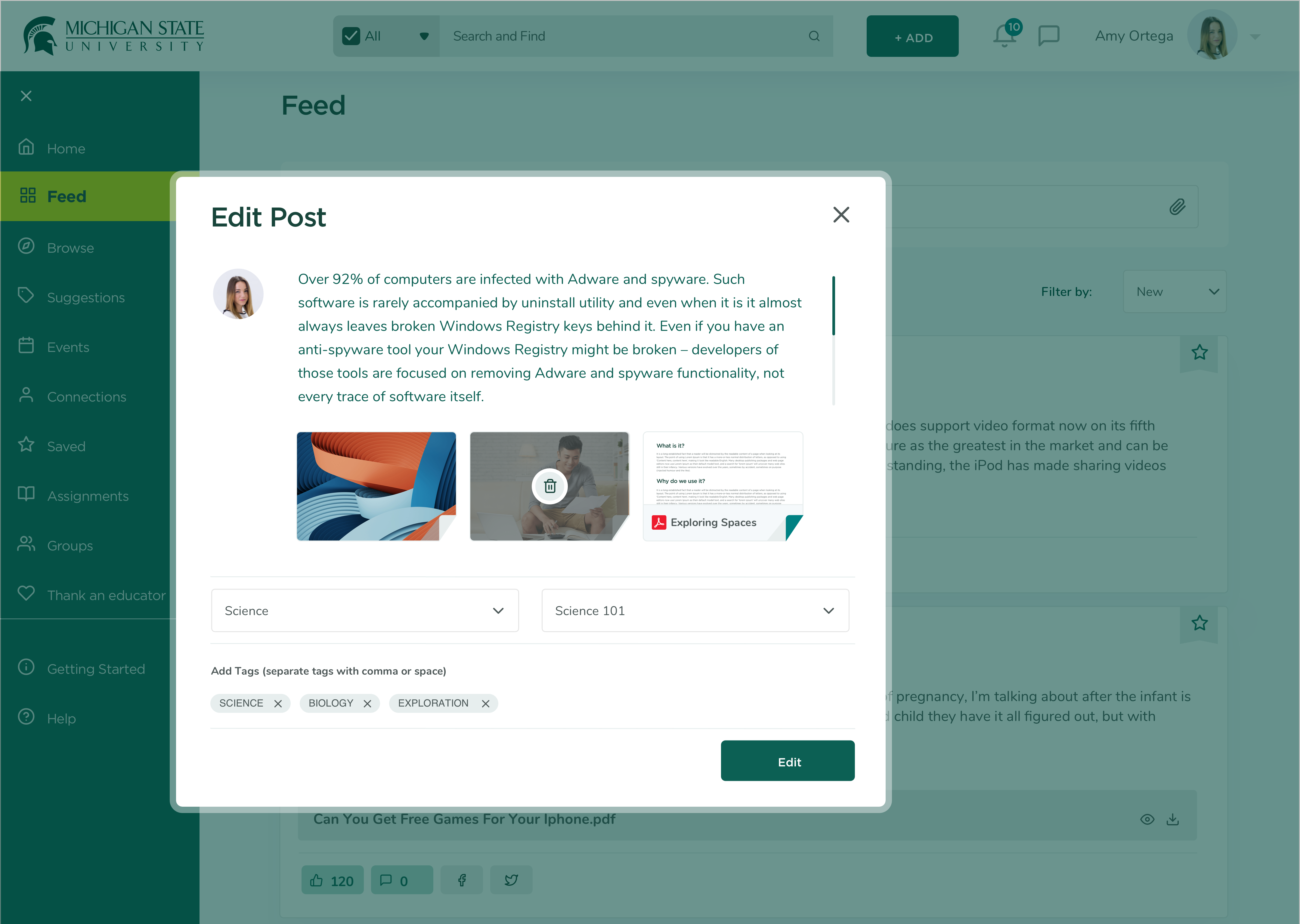Browse
Assessing Learning
Posted on: #iteachmsu



Posted by
over 4 years ago

Test : category-2
Mobile edit trial : When asking students to explore issues of personal and social identity, teachers must provide safe spaces in which students are seen, valued, cared for, and respected. It is also important that students have opportunities to learn from one another’s varied experiences and perspectives. To create this learning environment, When asking students to explore issues of personal and social identity, teachers must provide safe spaces in which students are seen, valued, cared for, and respected. It is also important that students have opportunities to learn from one another’s varied experiences and perspectives. To create this learning environment,
Mobile edit trial : When asking students to explore issues of personal and social identity, teachers must provide safe spaces in which students are seen, valued, cared for, and respected. It is also important that students have opportunities to learn from one another’s varied experiences and perspectives. To create this learning environment, When asking students to explore issues of personal and social identity, teachers must provide safe spaces in which students are seen, valued, cared for, and respected. It is also important that students have opportunities to learn from one another’s varied experiences and perspectives. To create this learning environment,
Assessing Learning
Posted on: #iteachmsu


Posted by
over 4 years ago
Abcd testvbjtestvbjtestvbjtestvbjtestvbjtestvbjtestvbjtestvbjtestvbjtestvbjtestvbjtestvbjtestvbjtestvbjtestvbjtestvbjtestvbjtestvbjtestvbjtestvbjtestvbjtestvbjtestvbjtestvbjtestvbjtestvbjtestvbjtestvbjtestvbjtestvbjtestvbjtestvbjtestvbjtestvbjtestvbjtestvbjtestvbjtestvbjtestvbjtestvbjtestvbjtestvbjtestvbjtestvbjtestvbjtestvbjtestvbjtestvbj
testvbj
thjjk
testvbj
thjjk
Posted on: #iteachmsu



Posted by
over 4 years ago

The 4Cs for 21st century learning are Creativity, Critical Thinking, Communication, and Collaboration. They are part of the framework for 21st Century Learning and are designed to support student learning in today’s world and are skills they can use in college and career.
Assessing Learning
Posted on: #iteachmsu


Posted by
over 4 years ago
The 4Cs for 21st century learning are Creativity, Critical Thinking, Communication, and Collaboration. They are part of the framework for 21st Century Learning and are designed to support student learning in today’s world and are skills they can use in college and career.
What is communication (and what isn’t it)?
The P21 framework emphasizes effective use of oral, written, and nonverbal communication skills for multiple purposes (e.g., to inform, instruct, motivate, persuade, and share ideas). It also focuses on effective listening, using technology to communicate, and being able to evaluate the effectiveness of communication efforts—all within diverse contexts (adapted from P21). Note that working in partners is a great way to collaborate or build shared understanding but a critical part of communication is sharing with an authentic audience.
What is communication (and what isn’t it)?
The P21 framework emphasizes effective use of oral, written, and nonverbal communication skills for multiple purposes (e.g., to inform, instruct, motivate, persuade, and share ideas). It also focuses on effective listening, using technology to communicate, and being able to evaluate the effectiveness of communication efforts—all within diverse contexts (adapted from P21). Note that working in partners is a great way to collaborate or build shared understanding but a critical part of communication is sharing with an authentic audience.
Assessing Learning
Posted on: #iteachmsu



Posted by
over 4 years ago

Dwyer, K. K., Bingham, S. G., Carlson, R. E., Prisbell, M., Cruz, A. M., & Fus, D. A. (2004). Communication and connectedness in the classroom: Development of the connected classroom climate inventory. Communication Research Reports, 21(3), 264-272.
http://bit.ly/2s8jFEH
http://bit.ly/2s8jFEH
Assessing Learning
Posted on: #iteachmsu


Posted by
over 4 years ago
An internet layer is the second layer of the TCP/IP model.
An internet layer is also known as the network layer.
The main responsibility of the internet layer is to send the packets from any network, and they arrive at the destination irrespective of the route they take.
An internet layer is also known as the network layer.
The main responsibility of the internet layer is to send the packets from any network, and they arrive at the destination irrespective of the route they take.
Assessing Learning
Posted on: #iteachmsu


Posted by
over 4 years ago
The TCP/IP model was developed prior to the OSI model.
The TCP/IP model is not exactly similar to the OSI model.
The TCP/IP model consists of five layers: the application layer, transport layer, network layer, data link layer, and physical layer.
The first four layers provide physical standards, network interface, internetworking, and transport functions that correspond to the first four layers of the OSI model, and these four layers are represented in the TCP/IP model by a single layer called the application layer.
TCP/IP is a hierarchical protocol made up of interactive modules, and each of them provides specific functionality.
The TCP/IP model is not exactly similar to the OSI model.
The TCP/IP model consists of five layers: the application layer, transport layer, network layer, data link layer, and physical layer.
The first four layers provide physical standards, network interface, internetworking, and transport functions that correspond to the first four layers of the OSI model, and these four layers are represented in the TCP/IP model by a single layer called the application layer.
TCP/IP is a hierarchical protocol made up of interactive modules, and each of them provides specific functionality.
Posted on: #iteachmsu



Posted by
over 4 years ago

Computer network: Computer Network provides basic and advanced concepts of Data Communication & Networks (DCN). Our Computer Networking Tutorial is designed for beginners and professionals.
A computer network is a set of devices connected through links. A node can be a computer, printer, or any other device capable of sending or receiving the data. The links connecting the nodes are known as communication channels.
A computer network is a set of devices connected through links. A node can be a computer, printer, or any other device capable of sending or receiving the data. The links connecting the nodes are known as communication channels.
Assessing Learning
